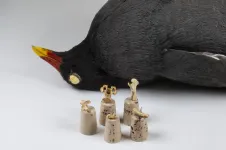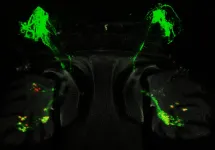(Press-News.org) Machine learning can be used to comb through online reviews of substance use treatment facilities to home in on qualities that are important to patients but remain hard to capture via formal means, such as surveys, researchers from the Perelman School of Medicine at the University of Pennsylvania show. The researchers found that professionalism and staff dedication to patients were two of the top qualities that could be attributed to either a negative or positive review of the facility. Findings from this study were published today in the Journal of General Internal Medicine.
"Searching for - and connecting with - therapy can be very difficult and confusing. Many individuals start their search online, where they are likely to see an online review accompanying other information about a treatment facility," said the study's lead author, Anish Agarwal, MD, a clinical innovation manager in the Penn Medicine Center for Digital Health and an assistant professor of Emergency Medicine. "These online reviews can provide commentary on what is driving positive, or negative, patient experiences throughout recovery, but they must be accurately identified. Through machine learning, we've shown that this is possible, and we hope such findings can be used to improve patient-centered addiction care."
Currently, there are no nationwide measures of quality to evaluate and compare facilities that treat substance use disorder. In the past, Agarwal - along with this study's co-author, Sharath Guntuku, PhD, a researcher in the Center for Digital Health and an assistant professor of Computer Science, and senior author Raina Merchant, MD, the director of the Center for Digital Health - analyzed reviews on Google and Yelp to see whether a national survey offered by the Substance Abuse and Mental Health Services Administration (SAMHSA) to inventory services being offered was also able to gauge patient satisfaction (it largely didn't). So the team set out to use a similar technique to gauge what drives positive or negative experiences with facilities through the unfiltered lens of Yelp.
"We felt that this would provide a great deal of insight into the patient experience," Guntuku said. "Tapping into user-generated reviews offers a way to understand their narrative."
To accomplish this, the researchers pulled reviews from SAMSHA-recognized facilities that had been reviewed at least five times. This amounted to more than 500 facilities across the United States. Text of the reviews were then run through a natural language processing algorithm powered by machine learning. Through this, topics were identified and collected from within the reviews. The researchers then were able to categorize them thematically.
Overall, the researchers classified 16 recurring themes in reviews. When it came to the positive reviews, the top themes were "long-term recovery," "dedicated staff," and "dedication to patients." The top three themes found in negative reviews were "professionalism," "phone communication," and "overall communication."
The fact that the top themes for both positive and negative reviews had to do with the conduct and commitment of facility staff does not come as a great surprise.
"Dedication and professionalism are critical to the recovery experience," Agarwal said. "Having trusted and approachable staff who care about individuals is the crux of all health care, but it is likely underscored in addiction."
Other top themes on the positive side were "group therapy experience" and "inpatient rehabilitation," while "wait times in facility" and "management" rounded out the top five most prevalent themes among negative reviews.
"We are still relatively early in this research, but we're getting a direct look into some core values that substance use treatment facilities could use to guide and improve their treatment," Merchant said. "This feedback is tremendously valuable, and we're showing that it can be distilled effectively into key themes through the use of machine learning."
Agarwal said he and the other researchers are hoping to explore more ways that patients, families, and their support networks think about substance use treatment and health care as a whole.
"In today's digital world, there is a robust and enormous amount of interconnectedness which we can harness to drive forward quality care and support health systems in learning from their patients," Agarwal said.
INFORMATION:
Other authors on this study include Zachary Meisel, Arthur Pelullo, and Bill Kinkle.
Funding was provided by the National Institutes of Health (grant number NIH NIDA 1R21DA050761).
GAINESVILLE, Fla. --- In a genetic surprise, ancient DNA shows the closest family members of an extinct bird known as the Haitian cave-rail are not in the Americas, but Africa and the South Pacific, uncovering an unexpected link between Caribbean bird life and the Old World.
Like many animals unique to the Caribbean, cave-rails became extinct soon after people settled the islands. The last of three known West Indian species of cave-rails - flightless, chicken-sized birds - vanished within the past 1,000 years. Florida Museum of Natural History researchers sought to resolve the group's long-debated ancestry by analyzing DNA from a fossil toe bone ...
SAN FRANCISCO (March 16, 2021) - Over the course of Earth's history, several mass extinction events have destroyed ecosystems, including one that famously wiped out the dinosaurs. But none were as devastating as "The Great Dying," which took place 252 million years ago during the end of the Permian period. A new study, published today in Proceedings of the Royal Society B, shows in detail how life recovered in comparison to two smaller extinction events. The international study team--composed of researchers from the China University of Geosciences, the California Academy of Sciences, the University of Bristol, ...
(Vienna, March 17, 2021) When complex systems double in size, many of their parts do not. Characteristically, some aspects will grow by only about 80 percent, others by about 120 percent. The astonishing uniformity of these two growth rates is known as "scaling laws." Scaling laws are observed everywhere in the world, from biology to physical systems. They also apply to cities. Yet, while a multitude of examples show their presence, reasons for their emergence are still a matter of debate.
A new publication in the Journal of The Royal Society Interface now provides a simple explanation for urban scaling laws: Carlos Molinero and Stefan Thurner of the Complexity Science Hub Vienna (CSH) derive them from the geometry of a city.
Scaling laws in ...
The UK variant of SARS-CoV-2 spread rapidly in care homes in England in November and December last year, broadly reflecting its spread in the general population, according to a study by UCL researchers.
The study, published as a letter in the New England Journal of Medicine, looked at positive PCR tests of care home staff and residents between October and December. It found that, among the samples it had access to, the proportion of infections caused by the new variant rose from 12% in the week beginning 23 November to 60% of positive cases just two weeks later, in the week beginning 7 December.
In the south east of England, where the variant was most dominant, the proportion increased from 55% to 80% over the same period. In London, where the variant spread fastest, ...
Washington, DC, March 16, 2021 - A study in the Journal of the American Academy of Child and Adolescent Psychiatry (JAACAP), published by Elsevier, reports on the young adult assessment of the now 20-year longitudinal Boricua Youth Study (BYS), a large cohort that brings much needed insight about development and mental health of children from diverse ethnic background growing up in disadvantaged contexts.
The present article, with its companion report on prevalence of conditions and associated factors, provides an update on the study's fourth wave, which follows-up two probability-based population samples of children of Puerto Rican heritage. ...
Certain brightly colored coral species dotting the seafloor may appear indistinguishable to many divers and snorkelers, but Florida State University researchers have found that these genetically diverse marine invertebrates vary in their response to ocean warming, a finding that has implications for the long-term health of coral reefs.
The researchers used molecular genetics to differentiate among corals that look nearly identical and to understand which species best coped with thermal stress. Their research was published in the journal Ecology.
"Being able to recognize the differences among these coral species that cannot be identified in the field -- which are known as 'cryptic species' -- will help us understand new ways ...
The electron is one of the fundamental particles in nature we read about in school. Its behavior holds clues to new ways to store digital data.
In a study published in Nano Letters, physicists from Michigan Technological University explore alternative materials to improve capacity and shrink the size of digital data storage technologies. Ranjit Pati, professor of physics at Michigan Tech, led the study and explains the physics behind his team's new nanowire design.
"Thanks to a property called spin, electrons behave like tiny magnets," Pati said. "Similar to how a bar magnet's magnetization is dipolar, pointing from south to north, ...
The Volcano Alert Level (VAL) system, standardized by the United States Geological Survey (USGS) in 2006, is meant to save lives and keep citizens living in the shadow of an active volcano informed of their current level of risk.
A new study published in Risk Analysis suggests that, when an alert remains elevated at any level above "normal" due to a period of volcanic unrest, it can cause a decline in the region's housing prices and other economic indicators. Because of this, the authors argue that federal policymakers may need to account for the effects of prolonged volcanic unrest -- not just destructive eruptions -- in the provision of disaster relief funding.
A team of geoscientists and statistical experts examined the historical relationship ...
As researchers push the boundaries of battery design, seeking to pack ever greater amounts of power and energy into a given amount of space or weight, one of the more promising technologies being studied is lithium-ion batteries that use a solid electrolyte material between the two electrodes, rather than the typical liquid.
But such batteries have been plagued by a tendency for branch-like projections of metal called dendrites to form on one of the electrodes, eventually bridging the electrolyte and shorting out the battery cell. Now, researchers at MIT and elsewhere have found ...
Even though a fruit fly doesn't have ears, it can hear with its antennae. In a END ...




